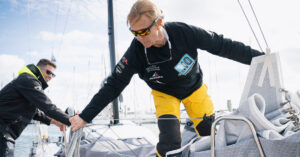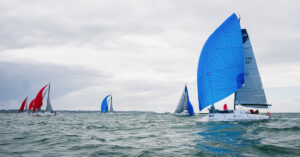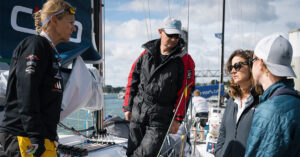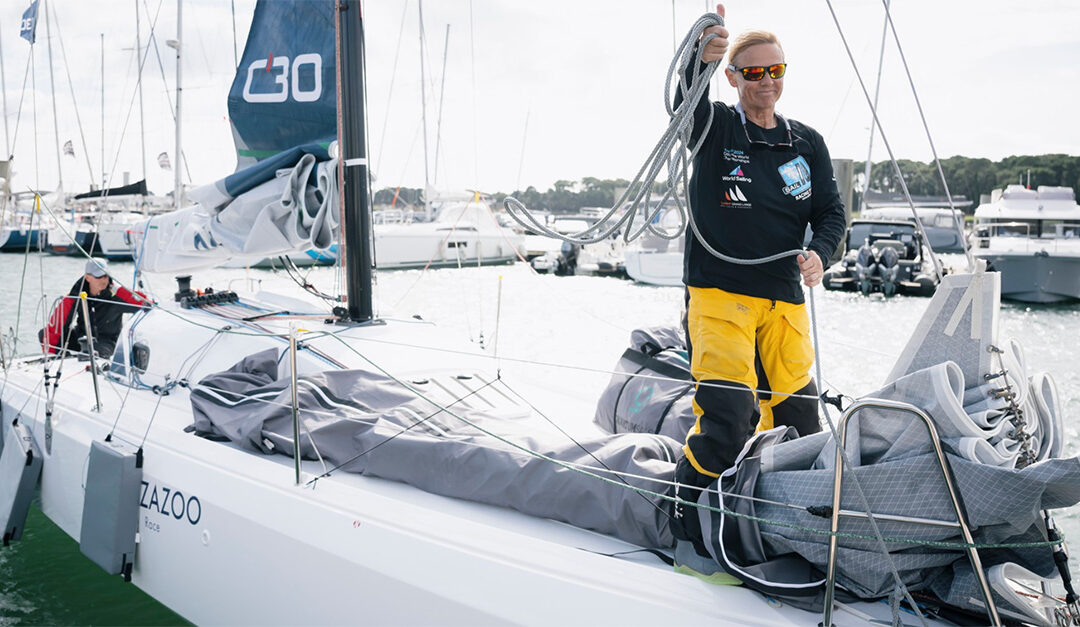They saw winds in excess of 30 knots and faced waves over three metres. They broached twice, destroyed their A4 asymmetrical spinnaker and then their A2, all the while playing a game of snakes-and-ladders on the leaderboard which saw them go from the high of 2nd to the low of last before eventually finishing a courageous 7th. After a protest that elevated them from 8th.
It’s fair to say the Région Bretagne – Elimination 2 race at the World Sailing Offshore Double Handed Championships off Lorient was a rollercoaster ride for Team Sail IQ Racing co-skippers Andrew Hall and Sandra Bees. They might have missed qualifying for the 48-hour final by just two spots, but they did Richmond Yacht Club and Yachting New Zealand proud in conditions so challenging that Bees cannot even remember what part of the race she suffered a fall that left her battered and bruised and firmly saying ‘no’ more.
In this, the first of a two-part feature, Bees gives her raw take on the race of her life.

“Shit got real very, very fast…”
By Sandra Bees/Team Sail IQ Racing
Where to start…
You are correct, my anxiety level was already high and the delay [more than 24-hours due to the storm conditions off Brittany] only heightened it. Trying to control my ‘overthinking’ took a lot of focus. Sometimes I won, sometimes my brain over-ruled me and I had moments of paralysing fear.
There was a lot of official stuff to cover off that I’d never experienced before. It was like going through airport security. Our carry-on gear was checked, weighed and tagged. We were allowed to take on 60kg.
I had to learn how to get into the engine compartment to put a seal around the engine once we had turned it off, prior to starting the race, sending in photographic evidence once done. When we had finished the race, it was the reverse, send a photo of the seal intact, ask for permission to cut it, once permission is received, send a photo of the cut seal and then put the engine in gear to come into the dock.
During this build-up I was fighting to keep my anxiety at bay. It helped having my daughter Jess here to talk about non-race related stuff, diverting my thoughts.
We got busy setting up, which helped settle some nerves. In keeping with the security, the anchor was sealed in place, along with emergency water – these were all checked again when we got back to the dock by the officials, to ensure we had not tampered with them.
Weirdly, once we were out on the water my anxiety all seemed to melt away, the sea state was not as bad as I had imagined, the breeze not as strong as I had feared. That was at the start… sea state no more than a metre swell, with a breeze of high teens to 20knots, all in all not too bad.
What they don’t tell you on the packet is that the start line was in the lee of Groix Island.
“Andrew said, you know we need to put the [Code] Zero up. I just looked at him and said ‘No’… I was tired, exhausted and my body just hurt everywhere…”
To my knowledge we had a good start. I was too busy to notice other boats, just head down, getting on with it. We flew the big blue gennaker, the A2, off the start. Once we were out from the island’s lee we were in 2-3 metre swells with 25-30 knots of breeze. Shit got real very, very fast, it was all on, no time for food, photos, other human needs, all forgotten. All focus was on keeping the boat upright and going. The months of training beforehand helped.
Whilst we had not sailed this boat in these conditions beforehand, the training we had done [off Auckland] and the 3 or so days we had spent on her helped our understanding of what was needed and when.

We put two reefs in the main and kept the A2 up. We would be surfing down waves, and then she would just plow headfirst into the next wave. We now understood how our Greek friends [Team Greece] found a couple of fish caught in the sails lying on their deck, when they had finished the first elimination race. This boat’s bow likes to go fishing! 🙂
Helming in these conditions, the angles we had chosen and the sail plan we had, needed a high level of helming skill acquired over years of helming in similar conditions. Andrew has that skill, I don’t. I think that was reflected by the fleet when only three boats flew their A2’s.
However, we were on course to get to the bottom mark in good shape and we were just behind the French [Basile Bourgnon and Elodie Bonafous who also flew their blue A2 from the start and eventually won] when we got the gennaker wrapped during a gybe. We got the wrap out quickly and were underway without too much delay, but the sail had somehow got a tear in the middle panel near the head.
The wee tear got a little bigger, and then disaster struck when we got caught and rolled out [broached]. The head decided it no longer wanted to be attached to the body of the sail so it let go.
Again, we were on to it as fast as a rat up a drain pipe… got the many pieces of sail down, and quickly hoisted the A4 (fractional red gennaker), all still in 2-3 metres swells with gusts of 25+knots, me on the bow but in reality with no time to think about anything except getting a sail up so we could get underway again. Unfortunately that wasn’t before the ,entire fleet overtook us.
As we got the A4 up, during the hoist the metal clips [snap shackles] decided they didn’t want to be attached to the sail and they both let go, so then we had a gennaker flying with no sheets attached. Could anything else go wrong!
I “raced”, carefully, to the bow, attached one of the wayward sheets to the tack of the gennaker, we blew the tack line and pulled the genny in. Quickly repacked her and hoisted again, only to find a tear in the middle of her. As we had already ripped one sail apart, we decided to bring her down.
After that we had no other sail options so had to two sail it to the bottom mark – I thought we were done. On the tracker that I’ve looked at since, it looks like we were all quite close to each other – by that time it was dark and I couldn’t see too many other boats – so I thought we were last by miles.
Also at the rounding I thought the hard part was over. Little did I know! The beat up wind was not as calming as I thought it would be. The sea state felt worse but maybe that was because I couldn’t see it in the dark and the breeze did not seem to drop as predicted. In fact it felt like it got stronger, it was uncomfortable but at least we could get some rest and have some time to take in what was going on. I gave Andrew a break from the helm and that was when I saw a couple of other boats around.

The upwind beat was pretty uneventful. It rained, it blew, the sea state was nasty. We shook reefs out, we put them back in, we took turns resting, we ate, we rehydrated. As for thoughts, I’m not sure I was thinking much past the next few minutes, checking we were on course, checking the instruments, checking in with Andrew and feeling relieved that there was limited need for me to be on the bow for a while at least!
When we got to the last turning point, Andrew said, ‘you know we need to put the [Code] Zero up’. I just looked at him and said ‘No’. I was tired, exhausted and my body just hurt everywhere.
At some point in the race I fell. I can’t even remember which leg of the race it was but I remember falling down, landing near the companionway, within the cockpit. I remember it hurt my back and my hand but at the time we had stuff happening so I just got up and got on with whatever needed to be done.
By the time we got to the last leg of the race, my body had had time to recalibrate and send messages to my brain to let me know it was sore. When Andrew said let’s put the Zero up, I really didn’t think I was capable of doing it.
He’d been checking the tracker so I asked him if there was a chance we would be in the top 5, he said maybe, but if we don’t put it up we would be last. He didn’t argue with me, he accepted my ‘no’ – but then I didn’t want to be last, and I didn’t want to let the team down by allowing my aches and pains to rule me.
If you sign up to compete at this level, you have to work through the pain and just get the job done.
So I stopped feeling sorry for myself and we got the Zero up. By that time the wind had dropped, finally doing what was predicted, the sea state had calmed. We thenhad the most peaceful and calm sail home in that last leg to a beautiful sunrise and finish!
Then came the engine seal-cutting process, getting the sails down, (note – unbelievably, as tired as we were, Andrew and I did our best mainsail takedown and flake!), onto the dock, an inspection of the anchor and emergency water seals, boat tidy up and finally, about 2pm, we were home and we could sleep. And that is exactly what we did.
That’s my 50cents.
Tomorrow: Andrew Hall – ‘When things go bad, they normally go really bad…’
Photos: © Anne Beaugé


Recent Comments